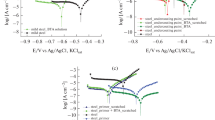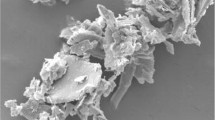Abstract
Corrosion processes of painted metals may be monitored by accelerated and/or electrochemical assays. There is certain relationship between both types of test. Particularly, when using paint coatings with high barrier effect (R > 108 Ω cm2) and low dielectric capacity (C < 10−9 F cm−2), a good anti-corrosion performance was accomplished and results from both types of tests match. Once corrosion has started, a charge transfer resistance value > 106 Ω cm2 ensures kinetic inhibition of the corrosion process. The question arises when the values of the above-mentioned parameters differ from those and a realistic approach to the coating useful service life is needed. In this paper, it was demonstrated that, in such cases, accelerated and electrochemical assays complement each other. Accelerated tests are related to coating durability while electrochemical ones provide information about the degradation mechanism. To carry out this investigation, three anti-corrosive paints containing ecological pigments were prepared and their protective behavior evaluated in the salt spray chamber and by electrochemical impedance spectroscopy (EIS).
Graphic abstract












Similar content being viewed by others
References
Sheridan H (2017) Paint toxicity and risks. http://www.buildingconservation.com/articles/lead-paint/lead-paint.htm
Wilbur S, Abadin H, Fay M, Yu D, Tencza MS (2000) Toxicologycal profile for chromium. Agency for Toxic Substances and Disease Registry Toxicological profile, Atlanta, pp 1–427
Ahmed NM, Mohamed MG, Abd El-Gawad WM (2018) Corrosion protection performance of silica fume waste-phosphates core-shell pigments. Pigm Resin Technol 47(3):261–271
Hao Y, Liu F, Han E-H, Anjum S, Xu G (2013) The mechanism of inhibition by zinc phosphate in an epoxy coating. Corros Sci 69:77–86
Shao Y, Jia C, Meng G, Zhang T, Wang F (2009) The role of a zinc phosphate pigment in the corrosion of scratched epoxy-coated steel. Corros Sci 51(2):371–379
Gerhard A, Bittner A (1986) Second generation phosphate anticorrosive pigments Formulating rules for full replacement of new anticorrosive pigments. J Coat Technol 58(740):59–65
Jašková V, Kalendová A (2012) Anticorrosive coatings containing modified phosphates. Prog Org Coat 75:328–334
Liu Y, Zhou X, Lyon SB, Emad R, Hashimoto T, Gholinia A, Thompson GE, Graham D, Gibbon SR, Francis D (2017) An organic coating pigmented with strontium aluminium polyphosphate for corrosion protection of zinc alloy coated steel. Prog Org Coat 102:29–36
Naderi R, Attar MM (2009) Electrochemical study of protective behavior of organic coating pigmented with zinc aluminum polyphosphate as a modified zinc phosphate at different pigment volume concentrations. Prog Org Coat 66:314–320
Naderi R, Attar MM (2009) The inhibitive performance of polyphosphate-based anticorrosion pigments using electrochemical techniques. Dyes Pigm 80:349–354
Khan MN, Mohammad F (2014) Eutrophication: causes, consequences and control, vol 2, 1st edn. Springer, London
Bohm S, McMurray HN, Powell SM, Worsley DA (2001) Novel environment friendly corrosion inhibitor pigments based on naturally occurring clay minerals. Mater Corros 52:896–903
Williams G, McMurray HN, Loveridge MJ (2010) Inhibition of corrosion-driven organic coating disbondment on galvanized steel by smart release group II and Zn(II)-exchanged bentonite pigment. Electrochim Acta 55:1740–1748
Kalendová A (1998) Anticorrosive spinel-type pigments of the second generation. Pigm Resin Technol 27(4):225–230
Grigoriev D (2015) Anticorrosion coatings with self recovering ability based on damaged triggered micro and nanocontainers. In: Tiwari A, Hihara L, Rawlins J (eds) Intelligent coatings for corrosion control butterworth-heinemann. Elsevier, Oxford, pp 283–333. https://doi.org/10.1016/b978-0-12-411467-8.00008-8
Appleman BR (1990) Survey of accelerated test methods for anti-corrosive coating performance. J Coat Technol Res 62(787):57–67
Meade CL (2005) Cabinet Tests. In: Baboian R (ed) Corrosion tests and standards, application and interpretation. ASTM International, West Conshohocken, pp 131–138
Dean SWJ (2005) Atmospheric. In: Baboian R (ed) Corrosion tests and standards—application and interpretation. ASTM International, West Conshohocken, pp 159–169
Walter GW (1986) A critical review of d.c. electrochemical tests for painted metals. Corros Sci 26(1):39–47
Walter GW (1986) A review of impedance plot methods used for corrosion performance analysis of painted metals. Corros Sci 26:681–703
Leidheiser H (1979) Electrical and electrochemical measurements as predictors of corrosion at the metal-organic coatings interface. Prog Org Coat 7:79–104
Santágata DM, Seré PR, Elsner CI, Di Sarli AR (1998) Evaluation of the surface treatment effect on the corrosión performance of paint coated carbón steel. Prog Org Coat 33:44–54
Seré PR, Santágata DM, Di Sarli AR, Elsner CI (1996) Study of commercially available epoxy protective coatings by using non-destructive electrochemical techniques. Corros Rev 14(1–2):87–97
Szauer T (1982) Electrical and electrochemical resistance for protective non metallic coatings. Prog Org Coat 10:157–170
Ming DW, Dixon JB (1987) Quantitative determination of clinoptilolite in soils by cation-exchange capacity method. Clays Clay Miner 35:463–468
Wolynec S (2003) Técnicas eletroquímicas en corroção. San Pablo
Nubiola (2018). http://www.nubiola.com/upfiles/files/newsnubiolai19.pdf
Alkipol 434/50 resin (2017). http://www.polidur.com.ar/info/ht/alquidicas/434-50%20A.pdf
Boukamp BA (1989) Equivalent circuit. University of Twente, Enschede
Datka J, Góra-Marek K (2004) Ir spectra of zeolites recorded at liquid helium temperature. Stud Surf Sci Catal Part B 154:1369–1374
Nabiollah M, Navid R, Homayon P, Farideh A, Karimi Shahraki B (2013) Porosity, characterization and structural properties of natural zeolite -Clinoptilolite- as a sorbent. Environ Prot Eng 39(1):139–152. https://doi.org/10.5277/EPE130111
Mahdavian M, Attar MM (2005) Evaluation of zinc phosphate and zinc chromate effectiveness via AC and DC methods. Prog Org Coat 53(3):191–194. https://doi.org/10.1016/j.porgcoat.2005.02.007
Blustein G, del Amo B, Romagnoli R (2000) Pore blocking by corrosion products. Eur Coat J 11:74–82
Amirudin A, Thierry D (1995) Application of Electrochemical impedance spectroscopy to study efficiency of anticorrosion pigments in epoxy-polyamide resin. Br Corros J 30:128–134
Ferraz O, Cavalcanti E, Di Sarli AR (1995) The characterization of protective properties for some naval steel/polymeric coatings/3%NaCl solution systems by EIS and visual assessment. Corros Sci 37:1267–1280
Haynes C, Baboian R (1985) Electromechanical impedance tests for protective coatings. ASTM Internationals, Philadelphia
Kendig M, Scully J (1990) Basic aspects of electrochemical impedance application for the life prediction of organic coatings on metals. Corrosion 46:22–29
Mansfeld F (1981) Recording and analysis of AC impedance data for corrosion studies. Background and methods of analysis. Corrosion (NACE) 36(5):301–307
Skale S, Doleček V, Slemnik M (2008) Electrochemical impedance studies of corrosion protected surfaces covered with epoxy polyamide coating system. Prog Org Coat 62:387–392
Szauer T (1982) Impedance measurements for the evaluation of protective nonmetallic coatings. Prog Org Coat 10(171–183):171
Simões AMP, Carbonari RO, Di Sarli AR, del Amo B, Romagnoli R (2011) An environmentally acceptable primer for galvanized steel: formulation and evaluation by SVET. Corros Sci 53:464–472
Acknowledgements
The authors thank the Consejo Nacional de Investigaciones Científicas y Técnicas (CONICET), Universidad Nacional de La Plata (UNLP) and Comisión de Investigaciones Científicas of the Buenos Aires Province (CICPBA), for the economic support to do this research.
Author information
Authors and Affiliations
Corresponding author
Additional information
Publisher's Note
Springer Nature remains neutral with regard to jurisdictional claims in published maps and institutional affiliations.
Rights and permissions
About this article
Cite this article
D’Alessandro, O., Selmi, G.J., Di Sarli, A.R. et al. Accelerated tests, a necessary complement of electrochemical assays to evaluate anti-corrosive coatings. J Appl Electrochem 49, 811–822 (2019). https://doi.org/10.1007/s10800-019-01324-z
Received:
Accepted:
Published:
Issue Date:
DOI: https://doi.org/10.1007/s10800-019-01324-z




